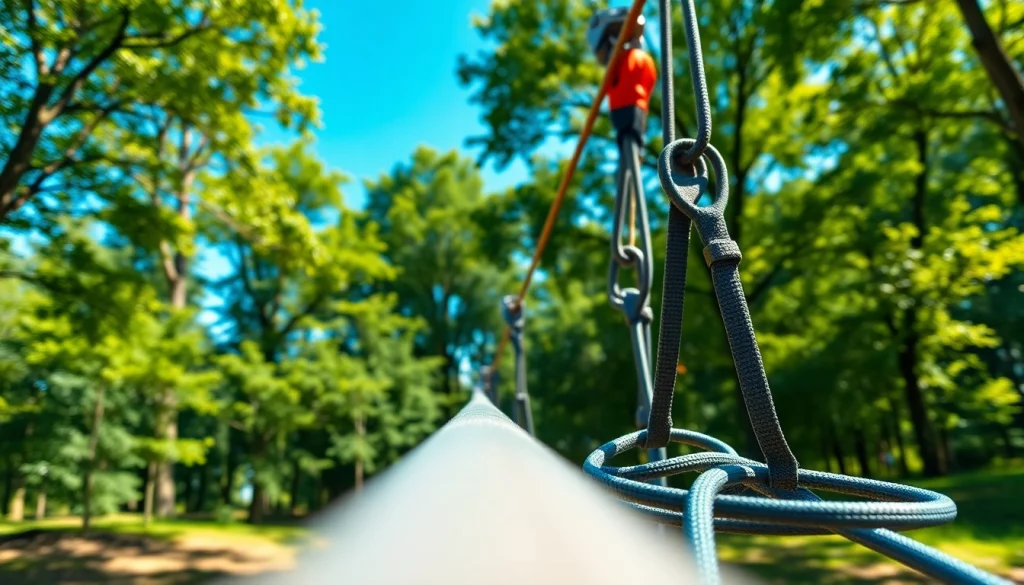Introduction to the ZIP WIRE KIT
If you’re looking for an exhilarating way to experience the great outdoors, investing in a ZIP WIRE KIT is a fantastic option. These kits not only provide fun but also foster a sense of adventure and exploration. A zip wire, also known as a zip line, allows individuals to glide from one point to another, typically high above the ground, which creates an adrenaline-fueled experience that people of all ages can enjoy.
The concept of zip lining has evolved from a simple cable system used in treetop research and exploration to a widely popular recreational activity. As more people seek out adventures that blend thrills with the beauty of nature, the demand for ZIP WIRE KITs has surged. This comprehensive guide will explore the essential components of a ZIP WIRE KIT, factors to consider when selecting one, a step-by-step setup and safety checks, best practices for usage, and maintenance tips to keep your kit in optimal condition.
Understanding Components of a ZIP WIRE KIT
A ZIP WIRE KIT is typically composed of several key components designed for safety and performance. Understanding each part is essential for making informed purchasing decisions and knowing how to effectively set it up.
- Cable: The cable is the heart of the zip wire. It is typically made from steel and designed to support the weight of riders while allowing smooth gliding. The quality and thickness of the cable can vary, impacting its durability and load capacity.
- Pulley: The pulley allows the rider to glide smoothly along the cable. Pulleys are designed to withstand significant pressure and friction, making it crucial for safe and enjoyable rides.
- Harness: A well-constructed harness secures the rider safely to the pulley. It plays a vital role in ensuring rider safety and comfort during the zip line experience.
- Anchor Points: These are used to secure the cables at both ends of the zip line. The anchor points must be sturdy and properly installed to handle various forces during operation.
- Braking System: An essential safety feature that allows riders to slow down at the end of the line. Depending on the design, braking systems can be manual or automatic and should be regularly checked for functionality.
Importance of Safety Features
Safety should always be the top priority when it comes to outdoor activities, especially thrilling ones such as zip lining. A reliable ZIP WIRE KIT must integrate several safety features:
- Load Capacity Ratings: Every ZIP WIRE KIT should come with information on its load capacity. This ensures that users understand the maximum weight it can support, helping to prevent accidents.
- Quality Certifications: Kits that meet industry standards often have certifications (such as ISO or CE) that confirm the materials and construction methods meet safety regulations.
- Emergency Procedures: A good ZIP WIRE KIT should come with clear instructions on emergency procedures. Users should know what to do in case of unexpected incidents.
Popular Uses for ZIP WIRE KIT
ZIP WIRE KITs are versatile and can be used in various settings. Here are some popular uses:
- Personal Use: Families often purchase ZIP WIRE KITs for personal use in their backyards or local parks, offering exciting activities for kids and adults alike.
- Outdoor Adventures: Many adventure parks and recreational facilities use ZIP WIRE KITs as a part of their offerings, enhancing the thrill factor for visitors.
- Team Building: Businesses often utilize zip line activities as team-building exercises, helping improve communication and trust among team members in a unique setting.
Factors to Consider When Selecting a ZIP WIRE KIT
Choosing the right ZIP WIRE KIT involves careful consideration of several factors to ensure you select one that meets your needs and provides a safe experience.
Weight Limitations and User Capacity
Every ZIP WIRE KIT has specific weight limitations based on its design and materials used. It’s essential to review the manufacturer’s guidelines to ensure that everyone who plans to use the kit falls within the acceptable weight range. Overloading the kit can lead to dangerous situations, and ignoring these guidelines can void warranty and safety features.
Material Quality and Durability
Investing in a high-quality ZIP WIRE KIT is crucial for safety and longevity. Materials such as high-tensile strength steel for cables and corrosion-resistant metals for pulleys and harnesses are ideal for ensuring durability. Before purchasing, look for kits that offer warranties or guarantees, which often indicate a commitment to quality.
Installation Requirements
Some ZIP WIRE KITs require professional installation, while others can be set up independently. Evaluate the installation requirements, including site preparation and equipment needed. If you’re opting for a DIY setup, ensure you have the necessary tools and follow the provided instructions closely. If unsure, consider hiring a professional for installation to avoid safety risks.
Setting Up Your ZIP WIRE KIT
Proper setup is vital to ensure safety and functionality. Here is a structured approach to setting up your ZIP WIRE KIT.
Site Selection and Preparation
The first step in setting up a ZIP WIRE KIT is choosing the right location. Factors to consider include:
- Elevation: The starting and ending points should be significantly elevated for fast rides. Look for a natural slope to enhance the experience.
- Surrounding Environment: Ensure that the area around the cable is clear of obstacles, including trees, buildings, and utilities.
- Space Requirements: Make sure there is adequate space for the approach and landing areas for safety.
Step-by-Step Installation Guide
Once the site is prepared, follow these general steps to install your ZIP WIRE KIT:
- Secure Anchor Points: Install anchor points securely at both the starting and ending locations. Ensure they are anchored according to the instructions provided in the kit.
- Attach the Cable: Thread the cable through the pulleys and anchor it at both ends, making sure it is tight and secure.
- Install Braking System: If your kit has a braking system, install it following the manufacturer’s guidelines.
- Test the Setup: Before allowing anyone to use the zip line, conduct thorough tests to confirm everything is secure and functioning correctly.
Safety Checks Before Use
Before the first ride, it’s essential to perform a series of safety checks:
- Inspect Hardware: Check all components for wear and tear, ensuring that cables, pulleys, and harnesses are in good condition.
- Check Weight Limits: Confirm that all users adhere to the weight capacity guidelines provided with your ZIP WIRE KIT.
- Review Emergency Procedures: Make sure all participants understand how to safely exit the zip line in case of an emergency.
Best Practices for Using a ZIP WIRE KIT
For both first-time users and seasoned adventurers, following best practices when using a ZIP WIRE KIT enhances the overall experience and ensures safety.
Instructions for First-Time Users
For those new to zip lining, follow these guidelines to ensure a safe and enjoyable experience:
- Wear Appropriate Gear: Use a fitted harness and helmet. Loose clothing can get caught in equipment.
- Follow Instructions: Pay close attention to the safety briefing provided by the instructor or provided in the kit.
- Begin with Small Heights: Start on shorter lines or lower altitudes to build confidence before attempting higher zip lines.
Common Mistakes to Avoid
Knowing what not to do can be just as important as knowing the right practices:
- Ignoring Weight Limits: Always adhere to the specified weight limits as exceeding them can compromise safety.
- Forgetting Safety Checks: Never skip safety inspections, and always check your harness and gear before each use.
- Not Following Instructions: Always follow operational instructions, especially regarding the braking system and the riding sequence.
Enhancing Your ZIP Wire Experience
To make the most out of your zip lining experience, consider the following:
- Bring a Friend: Sharing the adventure with others can enhance the experience and create lasting memories.
- Document the Moment: Use a camera or smartphone to capture the thrills and enjoy the moments together.
- Explore Different Locations: Don’t hesitate to try different zip lines in various locations to experience a variety of views and heights.
Maintenance and Care for Your ZIP WIRE KIT
Maintaining your ZIP WIRE KIT is essential for safety and longevity. Regular checks and proper storage can significantly extend the life of your equipment.
Regular Inspection and Servicing
Establish a routine for inspecting your ZIP WIRE KIT:
- Monthly Checks: Inspect cables, pulleys, and harnesses monthly for signs of wear and tear.
- Post-Use Inspections: After every use, check all components for any changes in condition, especially after heavy use.
- Professional Servicing: Consider having a professional inspect your ZIP WIRE KIT annually to ensure all safety standards are met.
Storage Recommendations
Storing your ZIP WIRE KIT properly can prevent damage and prolong its lifespan:
- Avoid Moist Environments: Keep equipment dry and away from moisture, as dampness can lead to corrosion and rust.
- Store in a Cool Area: Avoid extreme temperatures, as prolonged heat can degrade materials.
- Keep Out of Direct Sunlight: UV rays can weaken harnesses and other components; storing in shaded or covered areas is ideal.
Troubleshooting Common Issues
Maintenance may uncover issues needing attention:
- Slipping Pulleys: If pulleys are not moving smoothly, check for debris or wear that may require cleaning or replacement.
- Worn Cables: Replace cables immediately if you see any fraying, kinks, or cuts to ensure rider safety.
- Harness Repairs: If a harness has tears or broken parts, refrain from using it and consult the manufacturer for replacement options.


